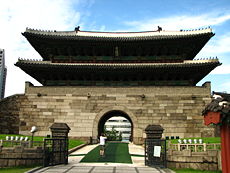Namdaemun
| Sungnyemun Namdaemun |
||||||||
|---|---|---|---|---|---|---|---|---|

Namdaemun before the fire.
|
||||||||
| Korean name | ||||||||
|
Sungnyemun or more commonly known as Namdaemun is a historic gate located in the heart of Seoul, the capital of South Korea. The landmark is officially called Sungnyemun, literally "Gate of Exalted Ceremonies," as written in hanja on a plaque on the wooden structure.[1] As the southern gate of the original walls surrounding Seoul during the Joseon Dynasty, it is widely known as Namdaemun, literally "Great Southern Gate." It is the first among the National Treasures of South Korea.
The wooden portion atop the gate was severely damaged by arson in the 2008 Namdaemun fire.[2]
Contents |
History

Before the 2008 fire, Namdaemun was the oldest wooden structure in Seoul.[3] The city gate, made of wood and stone with a two-tiered, pagoda-shaped tiled roof, was completed in 1398 and originally used to greet foreign emissaries, control access to the capital city, and keep out Korean tigers, which have long been gone from the area. Construction began in 1395 during the fourth year of the reign of King Taejo of Joseon and was finished in 1398. The structure was rebuilt in 1447 and was renovated several times since.[3] It was originally one of three main gates, the others being the East Gate (Dongdaemun) and the now-demolished West Gate in the Seodaemun-gu district, named after the old gate.[4]
In the early part of the 20th century, the city walls that surrounded Seoul were demolished by the Japanese Government, ostensibly "to ease the flow of traffic in the area." A visit to Seoul by the Crown Prince of Japan prompted the demolition of the walls around Namdaemun, as the prince was deemed to be too exalted to pass through the gateway.[5] The gate was closed to the public in 1907 after the Japanese colonial authorities constructed an electric tramway nearby. Namdaemun was extensively damaged during the Korean War and was given its last major repair in 1961, with a completion ceremony held on May 14, 1963. [6] It was given the status of "National Treasure No.1"[7] on December 20, 1962.
The Gate was renovated again in 2005 with the building of a lawn around the gate, before being opened once again to the public with much fanfare on March 3, 2006.[8] During the restoration, 182 pages of blueprints for the gate were made as a contingency against any emergencies which may damage the structure.[9]
Fire

At approximately 8:50 p.m. on February 10, 2008, a fire broke out and severely damaged the wooden structure at the top of the Namdaemun gate. The fire roared out of control again after midnight and finally destroyed the structure, despite the efforts of more than 360 firefighters.[10] Many witnesses reported seeing a suspicious man shortly before the fire, and two disposable lighters were found where the fire was believed to have started.[10] A 69-year-old man identified as Chae Jong-gi was arrested on suspicion of arson and then later confessed to the crime.[11][12][13] A police captain reported that Chae sprayed paint thinner on the floor of the structure and then set fire to it.[14] Police say that Chae was upset about not being paid in full for land he had sold to developers.[12] The same man had been charged with setting a fire at Changgyeong Palace in Seoul in 2006.[15]
The Cultural Heritage Administration of South Korea said that it would undertake a three-year project that would cost an estimated ₩20 billion (approximately $21 million) to rebuild and restore the historic gate.[16] President Lee Myung-bak has proposed starting a private donation campaign to finance the restoration of the structure.[17]
Location
The gate is located in Seoul Special City, Jung-gu, Namdaemun St 4-Ga 29, halfway between Seoul Station and Seoul City Plaza. Nearby is the Namdaemun market, a traditional twenty-four hour market that has been operating for centuries.
Gallery
See also
- Dongdaemun - the Great East Gate
- Kinkaku-ji - The Japanese temple was damaged by a monk's arson attack in 1950 and reconstructed in 1956. Rokuon-ji is its formal name.
- Arson
References
- ↑ Kwang-Tae Kim (2008-02-11). "South Korea arrests man in landmark fire", Associated Press, Yahoo! News.
- ↑ "S. Korean landmark collapses in fire", Associated Press, CNN (2008-02-11).
- ↑ 3.0 3.1 "Fire ravages South Korea landmark", BBC News (2008-02-11). Retrieved on 2008-02-11.
- ↑ Seth, Michael J (2006). A Concise History of Korea: From The Neolithic Period Through the Nineteenth Century. Rowman & Littlefield. p. 204.
- ↑ Hong Seong-tae (2004). "From Mount Baekak to the Han River: A Road to Colonial Modernization". in LaMarre, Thomas; Kang, Nae-hŭi. Impacts of Modernities. Hong Kong University Press. p. 126.
- ↑ Rahn, Kim (2008-02-11). "Poor Security Blamed for Gate Burnout", Korea Times.
- ↑ Shin Hae-in (2008-02-13). "Controversy erupts over fundraising for historic gate", Yonhap News.
- ↑ Lankov, Andrei (2008-02-11). "Namdaemun Outlived War, Colonialism", Korea Times.
- ↑ Chung Ah-young (2008-02-11). "Three Years Needed for Restoration", Korea Times.
- ↑ 10.0 10.1 Kwok, Vivian Wai-yin (2008-02-11). "Korea's Historic Namdaemun Gate Toppled By Fire", Forbes.
- ↑ "Man 'confesses to S Korea blaze'", BBC News (2008-02-12).
- ↑ 12.0 12.1 Kim Tae-jong (2008-12-12). "Suspect Admits Arson on Namdaemun", Korea Times.
- ↑ "Man 'Arsonist Blames President Roh'", Korea Times (2008-02-14).
- ↑ "SKorea arsonist in Namdaemun fire had grudge over land dispute: police", Agence France-Presse, Google (2008-02-12).
- ↑ Hyung-Jin Kim (2008-02-11). "Fire destroys South Korean landmark", Associated Press, Yahoo! News. Retrieved on 2008-02-11.
- ↑ Choe Sang-Hun (2008-02-12). "South Korean Gate Destroyed in Fire", The New York Times.
- ↑ Kim Yon-se (2008-02-12). "Donation for Gate Restoration Proposed", Korea Times.